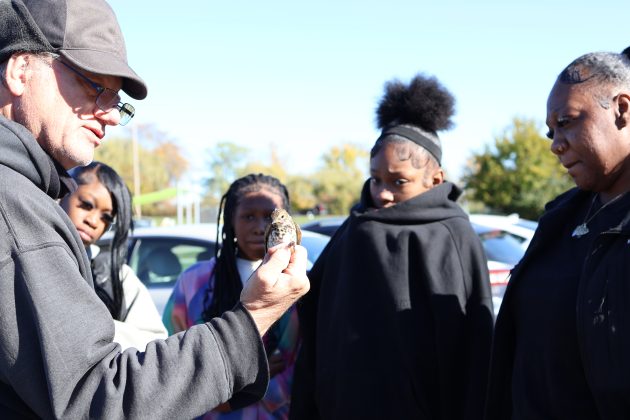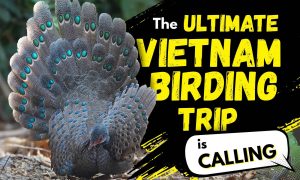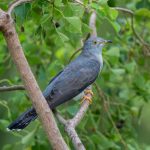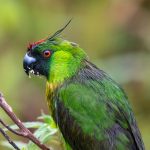
Allen Chartier has been a birder since the age of 11 when he received his first pair of binoculars and first bird book. However, he became aware of his interest years before age 11 thanks to an uncle who was a birder. Since then Allen has expanded his birding interests in a variety of different directions. He has been a field guide leading trips around the USA and South and Central America on an irregular basis. At age 19, he was the Vice President for Field Trips for Oakland Audubon Society (now Oakland Bird Alliance). The field trips Allen led included seeing the Greater Prairie-Chickens when they were still existing. In 1980 Allen organized a pelagic birding trip to Ocean City, Maryland. In 1989 and 1990, he co-led with a friend a couple of birding tours to the Yucatan in Mexico and to east Texas. On his own, he organized and escorted birding tours to Costa Rica (1996), Venezuela (2000), Ecuador (1998 and 2002), and Panama (2007). And, if that is not enough, he has been an environmental educator and is also an author: Michigan Breeding Bird Atlas II (available for download), American Birding Association Field Guide to Birds of Michigan (2018) and A Birder’s Guide to Michigan (ABA Birdfinding Guide) (2010). Finally, Allen became a bird bander 27 years ago which readers will learn about here. He maintains his blog, Michigan Hummingbird Guy, with details of his banding sessions and data. It would potentially embarrass Allen to write that, in the State of Michigan, he is nearly legendary for his innumerable contributions to birding and birders. There is almost certainly more to write about here; let us just say he has a long and well-established resume in birding.
On perhaps a half a dozen occasions this past spring and autumn I have stopped by Allen Chartier’s banding station on Belle Isle State Park in the middle of the Detroit River. His banding station is set up in the corner of a parking lot just adjacent to a children’s play area. From the hatchback of his Toyota Prius he pulls out and opens his table and, exactly so, arranges his banding tools. I watched him work with his personally trained team of volunteers and together they worked with skill and efficiency. They also appeared to be having a lot of fun. When Allen handled a bird he was so quick, conscientious and smooth; dare I say, he made it look easy—which I know it is not. I got the idea then to do this interview with Allen for readers of 10,000 Birds. The interview was conducted via email with questions submitted to Allen by both Kai Pflug and myself, Cathy Carroll. Hence, ringing vs. banding. So, here goes.
Kai: How did you get into bird ringing?
Allen: After high school I enrolled in a Michigan Birds class at the community college I was attending and I met Ellie Cox who was teaching the class. I was the only student who already had a life list. She was involved in a lot of projects to survey birds, as she was the Field Studies Coordinator for [then] Oakland Audubon Society (Oakland County, Michigan), and that included bird banding. Note that in the U.S. we call it banding instead of ringing. From 1989-1999 I helped at her station where she trained me in handling techniques (mist nets and the birds) as well as aging and sexing techniques. By 1997 I had started my own songbird banding station at nearby Holiday Beach Migration Observatory in Ontario, Canada under their station permit. Then in 2004 I re-started the banding station, where I was trained by Ellie, as she had retired in 1999.
Kai: How long have you been ringing birds?
Allen: As noted above, I started in the 1990s working under the supervision of others, but got my own Master Permit for hummingbirds only in Michigan in 2001, which I expanded to include “land birds” in 2004. I have personally banded about 80,000 birds of 142 species.
Kai: What qualifications are necessary to be a bird ringer?
Allen: It has been quite some time since I filled out my original application for a Federal Bird Banding permit, but at that time we had to provide references that we had sufficient training to be able to handle birds safely, to be able to handle mist nets, and to correctly age and sex any birds we were likely to encounter. Three references from ornithologists were required, so not just from the bander who trained me. I visited other banding stations to get a broader experience. Then, the application also required a research objective. What birds were intended to be banded, and for what purpose. Permits are good for 3 years and can be revoked for various reasons, including failure to submit data to the Bird Banding Lab (operated by the U.S. Geological Survey, part of the federal government), as well as other issues that proper training should prevent. And there are bander certification programs conducted by an organization outside the federal government, which I have taken and have been certified for songbirds.
Kai: What is the objective of your current banding project?
Allen: I am currently engaged in more than one project. I have just completed the first full year (spring and fall) of the migration monitoring and stopover ecology studies at Belle Isle State Park, which is in the Detroit River between the cities of Detroit, Michigan and Windsor, Ontario, Canada. In addition to monitoring variations in the species composition and numbers of migrants at the site in future years, the setup is designed to document the changes where nets are set up within and alongside a removed road (in 2022) on the island, and compare to an area that has not been modified. Other than several well-known bird observatories, long-term bird banding studies are not widespread in North America. I have collaborated in the past with researchers to collect single tail feathers to analyze stable isotope levels, and currently with the University of Colorado to collect tail feathers for their far-reaching Bird Genoscape project. A banding station like this also allows me to contribute to other studies such as collecting ticks for researchers in Michigan, and collecting Hippoboscid flies for Drexel University (Philadelphia, PA). I have also hosted unpaid interns to help with the experience in applying for certain programs at their colleges. A new project for 2026 is to attach satellite tags to thrushes (Veery, Gray-cheeked, Swainson’s, Hermit and Wood) to study their stopover habits and habitat use in more detail, as well as studying their broader migration over the course of multiple years. I have had the training necessary to attach these tags with harnesses, and my federal bird banding permit has been updated to reflect this. The Michigan Department of Natural Resources, who operates Belle Isle as a state park, has also insisted that this station serve a public education purpose. The public is welcome to stop by the banding table for impromptu brief lectures on whatever birds have been captured at the time. School groups are also scheduling visits.

This station is operated during spring migration (early April to early June) and fall migration (early August to early November). During the summer, I turn my attention to Ruby-throated Hummingbirds, which I have been banding in Michigan since 2001. I have approximately 25 study sites across the southern half of the Lower Peninsula (Michigan), all at private homes. I am studying their breeding success, number of broods per summer, migrations and molt. Later in summer and into early winter, my hummingbird efforts turn to “vagrant” species, and I travel within Michigan, Ohio and Indiana (each state requires a separate banding permit), sometimes traveling 8,000 miles (~12.9 million km!) in a season chasing these individuals. Rufous Hummingbirds are the most frequent “vagrants”, and I have learned that they are quite regular in small numbers in the Great Lakes area. I have had birds return to the same home in subsequent years, making the term “vagrant” erroneous. Some say these birds are “lost”, but that term is hard to apply to a bird that finds its way back to the same home 3 years in a row. Other hummingbird species that I’ve banded in this region include: Allen’s, Calliope, Costa’s, Anna’s, and Black-chinned. And finally, I have been banding in my small (0.15 acre) suburban yard in “winter” since 2004. I band 3 days each month from October to March, and have had many returns of winter resident species that do not breed here, including Dark-eyed Juncos and American Tree Sparrows.
Kai: Can you tell us the results of some of you previous ringing activities?
Allen: In 1997, I started the songbird banding station at Holiday Beach Migration Observatory in Ontario, Canada. In 2003, I left that station in the capable hands of those I trained (and those that they trained), and they are still banding there currently. From 2004 to 2023 I banded songbirds at Lake St. Clair Metropark in Macomb County, Michigan where I was studying the long-term trends of migrants, as well as their stopover ecology. The management of the park, and the park system, was very supportive of this effort until 2023 when they did not renew my research permit, citing issues that did not exist. So it is presumed that the new management did not appreciate the value of long-term bird studies. I had hoped to finish at this location in 2025, which would have given me 20 years of data to analyze and publish. I am still thinking about how to work up all of the collected data for publication.
Kai: Can you describe a typical day ringing birds? What do you do, and in what sequence?
Allen: This depends on which project I am working on! For the songbird banding on Belle Isle, I arrive on site at least an hour before sunrise with volunteers who can set up nets (we can only leave net poles on site due to the potential for vandalism, and nets are delicate and expensive). We walk the 15-acre area and set up to 16 nets with the objective of getting them open by dawn (30 minutes before sunrise). We then operate the station for 6 hours, doing net checks every 30 minutes with trained, experienced volunteers extracting birds from the mist nets and bringing the birds back to the banding table. This is currently set up from the back of my car in a parking lot adjacent to the Nature Center. The birds are banded, weighed and measured, and sometimes photographed if they are a rare species so that I can include them in my blog. They are then released. Repeat this process every 30 minutes until closing time 6 hours later when experienced volunteers go around and take the nets down. Hummingbird banding is more civilized! I arrive at a private residence, usually an hour after sunrise to allow the hummingbirds to feed a bit, I have one or two traps that I set up with a feeder inside. I then wait for the birds to enter the trap, take them out and band at the banding table and release. Mostly this is something I do alone, but there is one site in southwestern Michigan where it take 6 people to handle the 150+ hummingbirds that can be banded on the first morning there. These people include two banders who work as sub-permittees under my permit and are very capable and experienced.

Belle Isle State Park map. Banding area is circled; location of banding table is indicated with the arrow.
Kai: What are the biggest issues when ringing birds?
Allen: The number one issue is to make sure that the birds are safe. Are we handling them properly? Is it too cold or too hot to band? Should we close nets early due to temperatures, or if we’re catching too many birds? Is rain (or snow) coming that will force us to close? Are there predators in the area that we should be aware of? Another issue is damage to the delicate, expensive mist nets. Most often nets are damaged by White-tailed Deer running through them. It doesn’t do the deer any harm, but they can completely ruin a net by putting an 8 foot hole in it.
Kai: Are there birds or bird families that are particularly difficult to ring?
Allen: My permit does not cover all species, so I can’t speak about birds like waterfowl or seabirds. Some birds present challenges that you need to be prepared for through your training before getting a banding permit in the first place, and others are based on experience. Almost any bird can become tangled in a mist net in a way that requires more effort to extract it. Some birds, like Black-capped Chickadees, are very good at getting very tangled pretty consistently. On a difficulty of extraction scale 1 to 10, chickadees are often a 9 or 10—sometimes an 11. Wrens can also get very tangled. Larger birds, like Blue Jays, American Robins, Common Grackles and Mourning Doves, can be difficult to catch because they are larger than the nets can entangle. Mist nets come in a variety of mesh sizes, and the ones I use are optimized for warblers, sparrows and thrushes. Larger birds can bounce out or can get themselves out. Very rarely we catch hawks as large as Red-tailed Hawks, but more often smaller Sharp-shinned and Cooper’s hawks. If they haven’t bounced out of the net because of their size, great care must be taken during extraction to avoid getting impaled by their long, sharp talons! Hummingbirds require a special permit to band because of their small size and different handling and trapping techniques. In addition, the bands for hummingbirds are not provided pre-formed as songbird bands are. They come on a pre-printed flat sheet of aluminum and hummingbird banders must be able to cut these bands out with precision tools to within 0.05mm tolerance for proper fitting on the birds. Hummingbirds are not prone to stress any more than other birds (kinglets and Empidonax flycatchers can be more prone to stress than hummingbirds). But hummingbirds are small and not everyone can be successfully trained to handle and band them safely.

Allen holds a Hermit Thrush for visitors to his banding table to see up close.
Kai: Some people seem to have a somewhat critical attitude toward ringing birds—probably less as a matter of principle, but more because they think it is sometimes done by unqualified people and/or for irrelevant objectives. What are your thoughts?
Allen: I understand and have experienced that attitude. I have found that if I’m allowed to explain what I’m doing and show them the birds as I’m working on them, they can change their minds and become supportive of our efforts to study, and help, the birds. I think that I have answered in the questions above any doubts about “unqualified” people or “irrelevant” objectives, which are similar facts that I have related to skeptical observers. Rarely, I encounter individuals who are not willing to listen, and who are not convinced by facts or reality. There isn’t much to do about that.
Cathy: Allen, because Kai’s questions deal with the nuts and bolts of birding banding, my questions are somewhat different. Have you ever recaptured one of your own banded birds in a different year?
Allen: Recapture happens almost every day for species that are year-round residents or breeding birds at a site. And the more years of effort that is put in, the more we recapture. For species that are only migrants through a site, recaptures are very rare. I suspect that this is because variances in weather and wind can shift migration routes, and even if they shift only a mile or two, we won’t recapture them.
Cathy: Has one (or more) of your banded birds ever been re-encountered at a different banding location?
Allen: Yes, this has happened a few dozen times over the course of my nearly 30 years of banding. It is a rare occurrence though, and always cause for celebration.

A newly banded resident Downy Woodpecker
Cathy: And vice versa, have you ever captured a bird or birds that were originally banded at different locations?
Allen: Yes, this has happened more than a dozen times, but fewer than 20 times. Again, cause for celebration as it provides really good data on survivorship, migration routes, and longevity.
Cathy: My next question was about hummingbird banding, but you already responded to this in one of Kai’s questions. Nevertheless, you found space to add more information.
Allen: Yes, I think I covered the hummingbird permitting, capture and banding in one of the earlier questions, but in more detail I will say again that a permit to band hummingbirds is separate from the “land bird” permit that includes songbirds, shorebirds, hawks and owls—but not seabirds, waterfowl and other game birds (e.g. grouse). I had to be trained by a hummingbird bander, who for me was Bob Sargent (deceased in 2014). Bob was a leading authority on Ruby-throated Hummingbirds. I had the privilege of training with him in Alabama 26 years ago. I had to re-learn handling techniques as there are ways to hold a hummingbird that are different, and safer, than how we hold songbirds. Also, we take more measurements on hummingbirds, and have to watch for signs of stress (different bird families show stress in different ways). As already mentioned, the band-making is completely different from what other banders have to do, and it requires an ability to work with small things and to make quality bands.
Cathy: Finally, you must be getting tired of all these questions. But I am curious about your thoughts on one last question. If you have no preference one way or the other, please feel free to just respond no difference or no preference. Ringer vs. bander? Ringing vs. banding? Since 10,000 Birds is an international online birding site, I am wondering if you have any thoughts on the difference in nomenclature used in the U.S. vs. Europe and other countries?
Allen: It is what it is. We have other differences too. Color vs. colour. Shorebirds vs. waders. Loons vs. divers. We’re different cultures divided by a common language, as they say!
Cathy: Good answer Allen. And that’s where we’ll leave it. Let me close with a big thank you for taking so much of your time to answer our questions so thoroughly. I know you are busy with many things so this was no small act of generosity. We at 10,000 Birds all thank you.












Leave a Comment